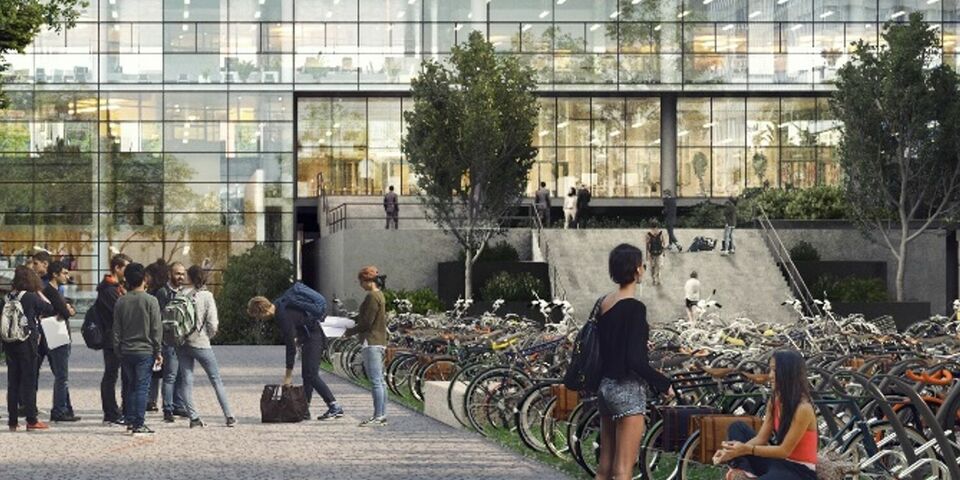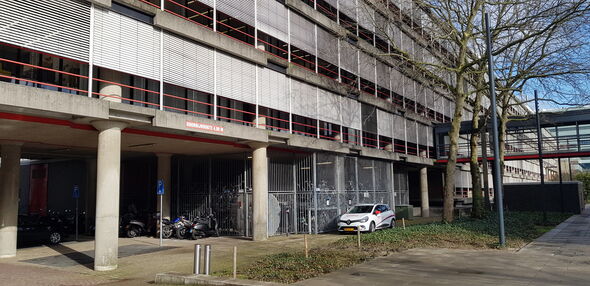First phase of Gemini renovation starts in spring of 2021
The renovation of Gemini, the building where the departments of Mechanical Engineering and Biomedical Engineering are housed, will take more than five years. The preliminary design was presented to the occupants on Monday. Not everything that was laid down in the Statement of Requirements could be incorporated. The building will not have an enclosed bicycle parking in the building, nor was there any space left for the lab of the Coherence and Quantum Technology group of Applied Physics. However, Gemini will have a virtual replica. At this stage, project leader Eric Heunen can’t say whether the nitrogen measures, as a result of which many construction projects are currently shut down or delayed, will cause problems.
TU/e alumnus Eric Heunen graduated at the department of the Built Environment in 1994. He has been working at Real Estate Management since July and was assigned the project management of the Gemini renovation last year. He describes it as a challenging task, one that will keep him occupied throughout the next few years with everything one might expect from a renovation project: demolition and sanitation, drawing up the final design, selecting a contractor, temporary relocations of occupants throughout the entire campus, and the construction of state-of-the-art lab facilities and innovative teaching rooms.
Complications
The preliminary design was supposed to be finished in the fall of 2019, but its presentation was delayed with approximately five months due to some complications. This doesn’t mean that time was lost, according to Heunen, “because we were able to focus extra attention on certain issues during the preparatory phase, we’ve made sure that possible future obstacles can be avoided.” This is illustrated by the decision not to house the lab of the Coherence and Quantum Technology group of Applied Physics in Gemini. Heunen: “It didn’t fit after all, and that decision created more breathing space during the design phase.”
Heunen says that many occupants also wanted to have some idea of what their future workplace might possibly look like, even though the project is still in its preliminary design phase and not yet in the next, conceptual phase, when these matters are usually further developed. “People worry that they otherwise end up in a situation that can’t be changed. That is why we addressed this issue at this earlier stage already.”
There won’t be room for an enclosed bicycle parking in the fully renovated Gemini building either. The semi enclosed bicycle parking on the west side of Gemini-Zuid will be converted into a teaching room; a solution for the bikes will be sought outside the building. “A possible location for that may be found between Gemini and the Laplace building,” Heunen says. “Gemini will have a second entrance at the north side, and we will call in the help of a landscape architect and TU/e’s quality committee to find a suitable location for the bicycle parking there.”
Three phases
One of the challenges during the coming years will be to make the renovation, which is planned in three phases, run smoothly. What will be of importance during this process is that research can continue, also at temporary locations. “We already designated several locations for that purpose. TU/e has set the commencement date for the rent of the Catalyst building, one of these locations, at an earlier date, because the proprietor would otherwise have rented out the building to another party,” Heunen says. “All of the temporary locations are on the TU/e premises, and in close collaboration with the two Departments we are fine-tuning where and when students, staff members and research facilities will move out.”
Heunen hopes to be finished with the final design by the end of 2020, after which the tender procedure and asbestos removal can commence. Gemini Noord will be renovated first. Heunen: “We will start with that around April 2021, and the installations and staff need to be housed elsewhere on campus before that time. Prior to that time, we will go through the entire building with the construction company, which will have been made public by then as well. This is not just because we want make an optimal technical design, but also because we want to take all the precautions in order to prevent inconvenience for the staff in Gemini Zuid during that first phase. We want to make sure that construction dust and noise won’t create a problem there.”
Gemini Noord will have to be brought back in use in early 2023, after which the renovation of Gemini Zuid will commence in two phases: phase one will take place between the spring of 2023 until the fall of 2024, and phase two starts in early 2025 and will last until mid-2026.
Digital twin
One of the things Heunen is proud of, is the multi-leveled innovative teaching rooms in Gemini Zuid. “That means that this room is suitable for frontal teaching and for working in small groups. The students will be located in one big room, but on different levels. Naturally, the entire building will be connected to TU/e’s heat and cold storage system, which means it will be gas-free. A completely digital version of the building will be developed as well, a so-called digital twin, so that it will also function as a living lab. The development of such a digital twin, a recent development in the construction sector, makes sure that you can constantly keep track of what goes on in a building, and where you might have to take action.”
Heunen can’t say whether the nitrogen measures will cause obstacles during the next few years. “Other groups within the university are currently looking into this campus wide. Such an approach might perhaps yield a solution to the nitrogen crisis.”
In the fall of 2018, Real Estate Management estimated the costs of the renovation at approximately one hundred million euros. At this point, Heunen can’t make any statements concerning this issue, except that the coordination between the design process and the construction costs and budget are being closely monitored during the design process. “As far as the tender is concerned, the market is quite volatile and other uncertain factors play a role as well, such as the issue of the nitrogen measures.”



![[Translate to English:] Artist impression van de ingang aan de zuidkant van Gemini. Illustratie | TW-IN [Translate to English:] Artist impression van de ingang aan de zuidkant van Gemini. Illustratie | TW-IN](/fileadmin/_processed_/1/7/csm_Gemini_render_2-KLEINER_3dc51c177c.jpg)
Discussion